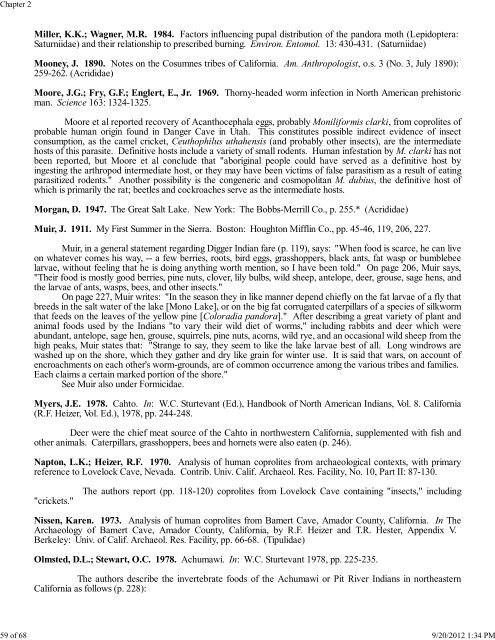Chapter 2. Insect Foods of North American Indigenous Populations ...
Chapter 2. Insect Foods of North American Indigenous Populations ...
Chapter 2. Insect Foods of North American Indigenous Populations ...
You also want an ePaper? Increase the reach of your titles
YUMPU automatically turns print PDFs into web optimized ePapers that Google loves.
<strong>Chapter</strong> 259 <strong>of</strong> 68 9/20/2012 1:34 PMMiller, K.K.; Wagner, M.R. 1984. Factors influencing pupal distribution <strong>of</strong> the pandora moth (Lepidoptera:Saturniidae) and their relationship to prescribed burning. Environ. Entomol. 13: 430-431. (Saturniidae)Mooney, J. 1890. Notes on the Cosumnes tribes <strong>of</strong> California. Am. Anthropologist, o.s. 3 (No. 3, July 1890):259-26<strong>2.</strong> (Acrididae)Moore, J.G.; Fry, G.F.; Englert, E., Jr. 1969. Thorny-headed worm infection in <strong>North</strong> <strong>American</strong> prehistoricman. Science 163: 1324-1325.Moore et al reported recovery <strong>of</strong> Acanthocephala eggs, probably Moniliformis clarki, from coprolites <strong>of</strong>probable human origin found in Danger Cave in Utah. This constitutes possible indirect evidence <strong>of</strong> insectconsumption, as the camel cricket, Ceuthophilus uthahensis (and probably other insects), are the intermediatehosts <strong>of</strong> this parasite. Definitive hosts include a variety <strong>of</strong> small rodents. Human infestation by M. clarki has notbeen reported, but Moore et al conclude that "aboriginal people could have served as a definitive host byingesting the arthropod intermediate host, or they may have been victims <strong>of</strong> false parasitism as a result <strong>of</strong> eatingparasitized rodents." Another possibility is the congeneric and cosmopolitan M. dubius, the definitive host <strong>of</strong>which is primarily the rat; beetles and cockroaches serve as the intermediate hosts.Morgan, D. 1947. The Great Salt Lake. New York: The Bobbs-Merrill Co., p. 255.* (Acrididae)Muir, J. 1911. My First Summer in the Sierra. Boston: Houghton Mifflin Co., pp. 45-46, 119, 206, 227.Muir, in a general statement regarding Digger Indian fare (p. 119), says: "When food is scarce, he can liveon whatever comes his way, -- a few berries, roots, bird eggs, grasshoppers, black ants, fat wasp or bumblebeelarvae, without feeling that he is doing anything worth mention, so I have been told." On page 206, Muir says,"Their food is mostly good berries, pine nuts, clover, lily bulbs, wild sheep, antelope, deer, grouse, sage hens, andthe larvae <strong>of</strong> ants, wasps, bees, and other insects."On page 227, Muir writes: "In the season they in like manner depend chiefly on the fat larvae <strong>of</strong> a fly thatbreeds in the salt water <strong>of</strong> the lake [Mono Lake], or on the big fat corrugated caterpillars <strong>of</strong> a species <strong>of</strong> silkwormthat feeds on the leaves <strong>of</strong> the yellow pine [Coloradia pandora]." After describing a great variety <strong>of</strong> plant andanimal foods used by the Indians "to vary their wild diet <strong>of</strong> worms," including rabbits and deer which wereabundant, antelope, sage hen, grouse, squirrels, pine nuts, acorns, wild rye, and an occasional wild sheep from thehigh peaks, Muir states that: "Strange to say, they seem to like the lake larvae best <strong>of</strong> all. Long windrows arewashed up on the shore, which they gather and dry like grain for winter use. It is said that wars, on account <strong>of</strong>encroachments on each other's worm-grounds, are <strong>of</strong> common occurrence among the various tribes and families.Each claims a certain marked portion <strong>of</strong> the shore."See Muir also under Formicidae.Myers, J.E. 1978. Cahto. In: W.C. Sturtevant (Ed.), Handbook <strong>of</strong> <strong>North</strong> <strong>American</strong> Indians, Vol. 8. California(R.F. Heizer, Vol. Ed.), 1978, pp. 244-248.Deer were the chief meat source <strong>of</strong> the Cahto in northwestern California, supplemented with fish andother animals. Caterpillars, grasshoppers, bees and hornets were also eaten (p. 246).Napton, L.K.; Heizer, R.F. 1970. Analysis <strong>of</strong> human coprolites from archaeological contexts, with primaryreference to Lovelock Cave, Nevada. Contrib. Univ. Calif. Archaeol. Res. Facility, No. 10, Part II: 87-130."crickets."The authors report (pp. 118-120) coprolites from Lovelock Cave containing "insects," includingNissen, Karen. 1973. Analysis <strong>of</strong> human coprolites from Bamert Cave, Amador County, California. In TheArchaeology <strong>of</strong> Bamert Cave, Amador County, California, by R.F. Heizer and T.R. Hester, Appendix V.Berkeley: Univ. <strong>of</strong> Calif. Archaeol. Res. Facility, pp. 66-68. (Tipulidae)Olmsted, D.L.; Stewart, O.C. 1978. Achumawi. In: W.C. Sturtevant 1978, pp. 225-235.The authors describe the invertebrate foods <strong>of</strong> the Achumawi or Pit River Indians in northeasternCalifornia as follows (p. 228):
















